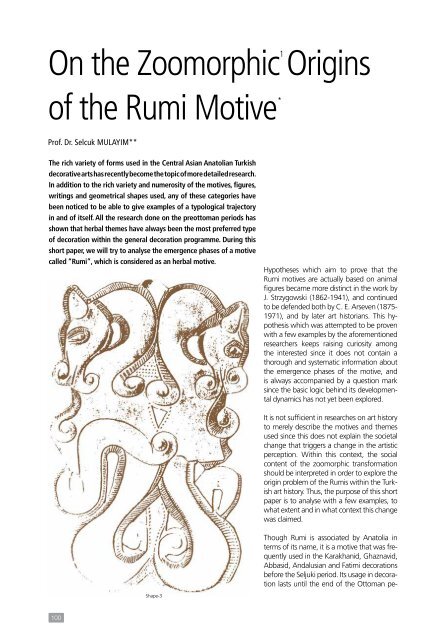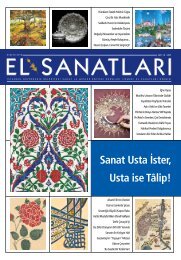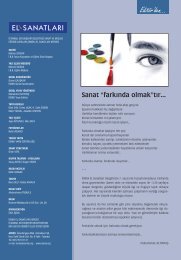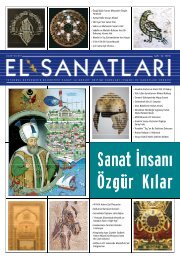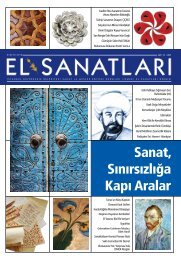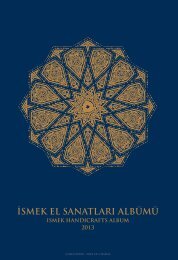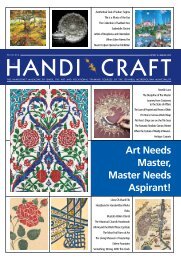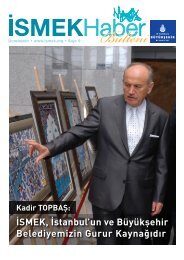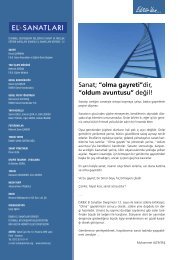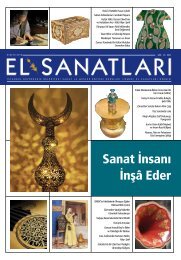On the Zoomorphic1Originsof the Rumi Motive*Prof. Dr. Selcuk MULAYIM**The rich variety of forms used in the Central Asian Anatolian Turkishdecorative arts has recently become the topic of more detailed research.In addition to the rich variety and numerosity of the motives, figures,writings and geometrical shapes used, any of these categories havebeen noticed to be able to give examples of a typological trajectoryin and of itself. All the research done on the preottoman periods hasshown that herbal themes have always been the most preferred typeof decoration within the general decoration programme. During thisshort paper, we will try to analyse the emergence phases of a motivecalled “Rumi”, which is considered as an herbal motive.Hypotheses which aim to prove that theRumi motives are actually based on animalfigures became more distinct in the work byJ. Strzygowski (1862-1941), and continuedto be defended both by C. E. Arseven (1875-1971), and by later art historians. This hypothesiswhich was attempted to be provenwith a few examples by the aforementionedresearchers keeps raising curiosity amongthe interested since it does not contain athorough and systematic information aboutthe emergence phases of the motive, andis always accompanied by a question marksince the basic logic behind its developmentaldynamics has not yet been explored.It is not sufficient in researches on art historyto merely describe the motives and themesused since this does not explain the societalchange that triggers a change in the artisticperception. Within this context, the socialcontent of the zoomorphic transformationshould be interpreted in order to explore theorigin problem of the Rumis within the Turkishart history. Thus, the purpose of this shortpaper is to analyse with a few examples, towhat extent and in what context this changewas claimed.Though Rumi is associated by Anatolia interms of its name, it is a motive that was frequentlyused in the Karakhanid, Ghaznavid,Abbasid, Andalusian and Fatimi decorationsbefore the Seljuki period. Its usage in decorationlasts until the end of the Ottoman pe-Shape-3100
iod. The name of the term, however, has anetimological intimacy with Anatolia only. Asknown, the word “rûm”, which means thecountry of the Romans, is used sometimesin order to describe the hole territories, andsometimes to explain the political structurein these lands. Just as the Seljuks who choseKonya as a center for themselves were called"Selâcika-i Rûm" (Anatolian Seljuks), thenames Bilad-i Rum, and Mevlana CelaleddinRumi have become generics as well. As far asour research is concerned, the term Rumi wasbeing commonly used in mid 16th century todefine the decorative term we know today.Mustafa Ali of Gelibolu (1541-1599) who weknow with his work called Menakib'ul-Hunerveranuses the term in the decorative contextin another work of his called Mevaidu'n-Nefâis fî Kavaidu'l-Mecâlis.The form called Rumi consists of a body in theshape of a fattish comma, and a round shapeattached to its sharp end. It may devaricate in2 pieces, or violates the generaldescription with body variationsthat are sliced with vanes. It maybecome longer, shorter or takedifferent forms. Although thecomposition in decoration generallylooks like waterleaves, whatis generally felt when looked ata standalone rumi motive is aggressive,scary, stinging motivesthat are branched in curls. An animallikecharacter which makesagile turning movements makesitself more obvious in details. In other terms,the moves of an animal, namely a snake, adragon, or any other ancient legendary creatureseems to come out of ancient fairy tales.Shape-4In early ages, namely before the 10th century,animals had an important status in thelives of Turks. The calendar that divided thetime into slices is known as the calendar withanimals. This calendar symbolized years withanimal figures.It is a fact that the art and culture of everysociety is related to more ancient historicallayers. Neither Seljukis, nor Ottomans are exceptionalto this. It is clearly seen that art aswell reached a turning point with the conversionof Turks into Islam.Some think that Turks had quite a difficultywhile adapting to this new discipline, whileothers think that it was not very difficult. Itshould not be possible, though, to formulatethis problem with a single statement. Thistransformation may be explained in the bestway only by analysing the related examples.A bronze standard (shape 1) that was foundin the Kuban region of the Caucasus looks inShape-2terms of its general figures like the head of araptorial. Dated around 500 BC, this bronzeis smaller than 30 CMs, and looks like it is inthe evolution process of a Rumi motive withits beak and the curls under its eyes as wellas at the back of its head. These signs thatwere obvious at least 1200 years before theemergence of the Islamic art are noteworthy.On the golden plate dated about a centurylater than the bronze standard, (shape 2),which is now exhibited in the Ermitaj Museumin Leningrad, a griphon attacking a horseis described. In addition to some Rumilikeforms in the details which can be seen on thewings of the griphon, the fact that all of thefigures on the plate which is about 12 CMswide are curled in the shape of the letter Smakes the plate look like having herbal patterns.The metal object found in the Krasnokutskregion of the Northern Blacksea lookslike the Pioneer of the Islamic decorative artwith symmetrically arranged horse headlikeforms, curls and tiny circular forms. Also,Shape-1Shape-5101
- Page 1:
Art Leads Oneto Eternity!
- Page 4 and 5:
In ThisEdition1506The StringentMast
- Page 6:
Dear Istanbulians,After the industr
- Page 10 and 11:
One Marbler Has Carried This Colorf
- Page 12 and 13:
this art”. Being single those day
- Page 14 and 15:
in flower marbling.” He says, and
- Page 16 and 17:
Cicek Derman: The DoyenneFlower of
- Page 18 and 19:
and does not want her to either stu
- Page 20 and 21:
der the very inside of you.” She
- Page 22 and 23:
ate” at all. The creator is one,
- Page 25 and 26:
Kundekâri:The Time Defying Heritag
- Page 27:
Cracks and incisions which could oc
- Page 30 and 31:
land to understand weather he can p
- Page 32 and 33:
When Deep WavesWash Ashore!by A. Ul
- Page 34 and 35:
'Bismillah' by Omer Faruk Deretaste
- Page 36 and 37:
'The Asr Surah' by Mustafa Cemil Ef
- Page 38 and 39:
Van Gogh,The Genious Painter of Yel
- Page 40 and 41:
and anxieties that surrounded him s
- Page 42 and 43:
The most prominent features which w
- Page 44 and 45:
Starry Night Over the Rhonehe opted
- Page 46 and 47:
the left side of his face is a colo
- Page 48 and 49:
The Threaded Version of Silver isRe
- Page 50 and 51:
out from a narrower hole. Theseoper
- Page 52 and 53: Sumi-e: The Elegance which Comesint
- Page 54 and 55: traditions, perform this art seated
- Page 56 and 57: sumed in half an hour after it is p
- Page 59 and 60: er in ISMEK, after her illumination
- Page 61 and 62: 59Illustration: Hatice Ozturk
- Page 63 and 64: there was a captures chamberlain. 5
- Page 65 and 66: lack sides. As far as I can see del
- Page 67 and 68: One of the founders of the civilisa
- Page 69 and 70: The miniature by Ochiai Yoshiiku da
- Page 71 and 72: Miniatures are in the Irony of West
- Page 73 and 74: pictions of various countries, coul
- Page 75 and 76: A miniature example from the work n
- Page 77 and 78: “Ve mâ rameyte iz rameyte ve lak
- Page 79 and 80: usually there is a part consisting
- Page 81 and 82: When applied on wood, Edirnekâri c
- Page 83 and 84: What is very distinct regardingthe
- Page 85 and 86: The ceiling decorations, corner cab
- Page 87 and 88: There is an epigram for the Artof C
- Page 89 and 90: If the paper had spoken and told wh
- Page 91 and 92: nailing, gluing or compressing of t
- Page 93 and 94: gold. The notebooks with gold leave
- Page 95 and 96: laminary and get the required thick
- Page 97 and 98: Both the insufficience of green fie
- Page 100 and 101: 15 years ago, Mr. Yesilce allocated
- Page 104 and 105: Shape-6Shape-13another finding foun
- Page 106 and 107: The Harem in the Topkapi Palace,The
- Page 108 and 109: very much like the school of boys i
- Page 110 and 111: The Blue Doors of TunisiaThe Articl
- Page 112 and 113: Tunisia is the pearl of the Mediter
- Page 114 and 115: Ottoman CultureProducts from Qadi R
- Page 116 and 117: An Overview of Written Sourcesin Ot
- Page 118 and 119: Signature of Abdulhamit II on the c
- Page 120 and 121: Pieces of Wastepapers TurnInto Jewe
- Page 122 and 123: in a short time, we ask him to make
- Page 124 and 125: Symbols of theLife of Thoughtby Pro
- Page 126 and 127: The Gulpayegan Masjid Kufi writing
- Page 128 and 129: which show some of the monumental w
- Page 130 and 131: An appearance from the interior of
- Page 132 and 133: The Kufic script at the top is prep
- Page 134 and 135: in yerinize grafologla konusuverir.
- Page 136 and 137: considered as a hard science rather
- Page 138 and 139: Zeynep Bornovali states that differ
- Page 140 and 141: The Dance of the Needle with Cerami
- Page 142 and 143: was not the case, however, for the
- Page 144 and 145: an area determined on the material
- Page 146 and 147: Dilek Hanif: A Fashion DesignerWho
- Page 148 and 149: others prefer to have a single and
- Page 150 and 151: Princess Nazli:The Patron of Arts a
- Page 152 and 153:
which was also known as “Villa He
- Page 154 and 155:
A Bouquet From the Hidden Paradiseb
- Page 156 and 157:
Canfeza (Heart touching) A fully st
- Page 158 and 159:
“Someone whom I hadn’t met befo
- Page 160 and 161:
The Storm of ISMEK Blowingin the In
- Page 162:
Menaf Nam's work which was awarded


